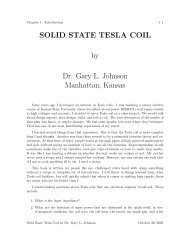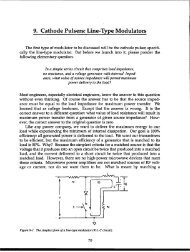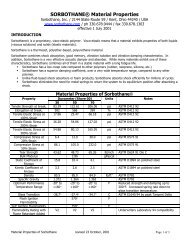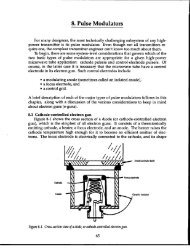3.6M north10.pdf - Dean-O's Toy Box
3.6M north10.pdf - Dean-O's Toy Box
3.6M north10.pdf - Dean-O's Toy Box
You also want an ePaper? Increase the reach of your titles
YUMPU automatically turns print PDFs into web optimized ePapers that Google loves.
Cathode Pulsers: Hard-Tube Modulators (10) 153<br />
with time. Any changes consist mostly of the capacitor-bank droop and the<br />
voltage drop across the surge-current-limiting resistors caused by the normal<br />
peak-load current. Before there were dependable high-performance optically<br />
coupled signal links, special pulse-transformer designs and even pulsed RF links<br />
were used to transmit low-level timing signals across the high-voltage gap, examples<br />
of which we will see later. As complicated as these circuits are, they are<br />
in most cases preferable to solving the problem of insulating the pulse-transformer<br />
primary winding for the full switch-tube operating voltag~specially<br />
because the performance of the pulse transformer is either the most important<br />
issue or second only to that of the switch tube itself.<br />
Circuit complications am also unavoidable in the final configuration, which<br />
is shown in Fig. 10-3d. This is the direct-drive hard-tube modulator—the top of<br />
the line, as it were. In this design, there is no pulse transformer at all. This<br />
feature eliminates the limitations on pulse duration, rise-and-fall times, intrapulse<br />
droop, and leading-edge overshoot &d ringing. The price paid for this imp~ovement<br />
is increased circuit complexity and the fact that the switch tube itself must<br />
handle the full operating voltage and current of the microwave tube load as<br />
separate and independent ratings-not as a peak-power product, where lack of<br />
voltage hold-off can be compensated for by increased current-handling (or viceversa)<br />
with any mismatch handled by an appropriate pulse-transformer turns<br />
ratio. This direct-drive connection is capable of the highest performance of all<br />
modulator types. Given enough excess capability, or head-room, it can be programmed<br />
to compensate for almost every shortcoming of the rest of a transmitter,<br />
including power-supply ripple, noise, and capacitor-bank droop. In fact,<br />
there is a class of switch tube, which will be described later, that will do much of<br />
this with no programming at all. Not surprisingly, therefore, this class of modu-<br />
I<br />
Figure 10-4. The back-swing clipper circuit as used with transformer-coupled unidirectional! [o&.







